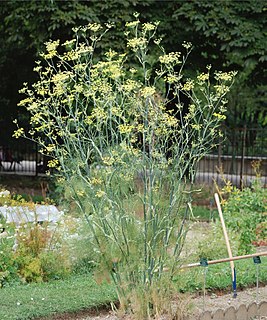Related Research Articles

Guava is a common tropical fruit cultivated in many tropical and subtropical regions. Psidium guajava is a small tree in the myrtle family (Myrtaceae), native to Mexico, Central America, the Caribbean and northern South America. Although related species may also be called guavas, they belong to other species or genera, such as the pineapple guava, Feijoa sellowiana. In 2018, India was the largest producer of guavas, with 45% of the world total.

Fennel is a flowering plant species in the carrot family. It is a hardy, perennial herb with yellow flowers and feathery leaves. It is indigenous to the shores of the Mediterranean but has become widely naturalized in many parts of the world, especially on dry soils near the sea-coast and on riverbanks.

The Tortricidae are a family of moths, commonly known as tortrix moths or leafroller moths, in the order Lepidoptera. This large family has over 10,350 species described, and is the sole member of the superfamily Tortricoidea, although the genus Heliocosma is sometimes placed within this superfamily. Many of these are economically important pests. Olethreutidae is a junior synonym. The typical resting posture is with the wings folded back, producing a rather rounded profile.

The light brown apple moth is a leafroller moth belonging to the lepidopteran family Tortricidae.

The Tortricinae are the nominate subfamily of tortrix moths. Commonly referred to as leafrollers, as the larvae build shelters by folding or rolling leaves of the food plant, the tortricinae include several notable pests as well species used as biological control agents against invasive weeds.

Acleris variegana, the garden rose tortricid moth or fruit tortricid, is a moth of the family Tortricidae. It has a Palearctic distribution. The moth flies from July to September mainly at night and is attracted to bright lights. The larvae feed on various trees and shrubs including rose and apple.

Choristoneura rosaceana, the oblique banded leaf roller or rosaceous leaf roller, is a moth of the family Tortricidae. It is native to North America, but has been accidentally introduced into other parts of the world.

Brabejum is a genus of a single species of large evergreen tree, Brabejum stellatifolium in the family Proteaceae, commonly called wild almond, bitter almond or ghoeboontjie. It is restricted in the wild to South Africa's Western Cape province, where it grows in thickets along the banks of streams. The plant is of botanical interest as being Africa's only member of the large grevilleoid subfamily. It is a bushy small tree with branches widely at ground level and numerous erect vigorous stems. Leaves grow up to 6 in (15 cm) long, narrow and bluntly toothed, appear at intervals along the branches, mostly in whorls of 6. In summer, the plant bears white flowers densely crowded on spikes arising from rusty buds at the leaf axils. The fruits to 2 in (5 cm) long, magenta to reddish brown, similar to an almond, appear in autumn. The nut is too bitter to eat; however, in earlier times it was boiled, roasted, and ground to make a "coffee" drink.
Gnathmocerodes is a genus of moths belonging to the subfamily Olethreutinae of the family Tortricidae.

Rhopobota naevana, the holly tortrix moth, holly leaf tier or blackheaded fireworm, is a moth of the family Tortricidae. It is found from Europe to eastern Russia, China, Taiwan, Mongolia, Korea and Japan. It is also present in India, Sri Lanka and North America.
Spheterista tetraplasandra is a moth of the family Tortricidae. It was first described by Otto Swezey in 1920. It is endemic to the Hawaiian island of Oahu.

Planotortrix excessana, the greenheaded leafroller, is a moth of the family Tortricidae. It is native to New Zealand and is an introduced species in Hawaii. It is extremely variable in appearance and feeds on many native and introduced species. It is regarded as a pest of some agricultural and forestry crops.

Argyrotaenia franciscana, the orange tortrix or apple skinworm, is a moth of the family Tortricidae. It is found from California north to Oregon and Washington.

Archips argyrospila, the fruit-tree leafroller moth, is a moth of the family Tortricidae. It is found in most of the United States and southern Canada.

Platynota rostrana, the omnivorous platynota moth, is a species of moth of the family Tortricidae. It is found from the United States, south through Mexico and Central America to South America. Its native range also includes the West Indies. It has been recorded from Europe, where it may temporarily establish through accidental importation in tropical plants.

Grapholita tenebrosana, the Grapholitha roseticolana, is a moth of the family Tortricidae. It was described by Philogène Auguste Joseph Duponchel in 1843. It is found from most of Europe east to Japan. The habitat consists of woodland, gardens, orchards, parks and scrubs.

Gynnidomorpha permixtana, the coast conch, is a moth of the family Tortricidae. The species was first described by Michael Denis and Ignaz Schiffermüller in 1775.
Argyrotaenia sphaleropa is a species of moth of the family Tortricidae. It is found in South America, where it has been recorded from Colombia, Bolivia, Brazil, Peru, Uruguay and Argentina.

Spatalistis bifasciana is a species of moth of the family Tortricidae. It is found in most of Europe.

Ulmus okanaganensis is an extinct species of flowering plant in the family Ulmaceae related to the modern elms. The species is known from fossil leaves, flowers, and fruits found in the early Eocene deposits of northern Washington state, United States and similar aged formations in British Columbia, Canada.
References
- ↑ Tortricid.net
- ↑ The South Asiatic Olethreutini: (Lepidoptera Tortricidae)
| This Olethreutini-related article is a stub. You can help Wikipedia by expanding it. |